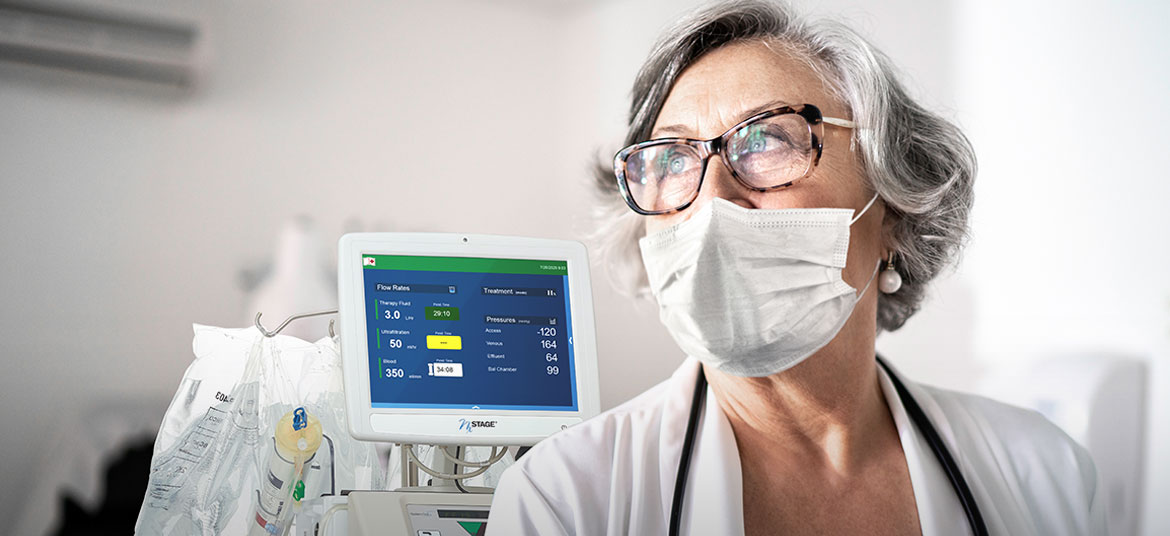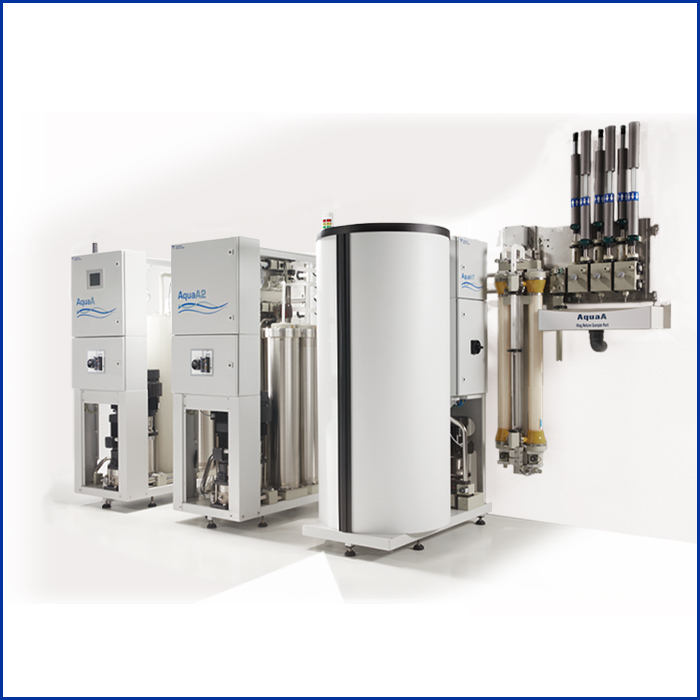
6 Critical Characteristics of Kidney Replacement Therapy (KRT) Machines During a Crisis
Whether their condition is acute or chronic, patients who are hospitalized with kidney failure need life sustaining dialysis. Delivery of this therapy cannot be halted or delayed indefinitely, even in the middle of difficult circumstances — whether staff shortages, natural disasters, water contamination, blackouts, or a pandemic.
Given the unpredictable nature of such events, hospitals need Kidney Replacement Therapy (KRT) equipment with a track record of maintaining continuity of care. As hospitals and other healthcare facilities assess which KRT technology is best suited for their emergency preparedness plans, there are several factors to bear in mind. Here we’ll explore six considerations.
1. Source Water Flexibility
Each year in the U.S., there are over 300,000 water main breaks, which averages out to 850 per day.1 Water emergencies, also caused by storms and power outages, often make public water sources undrinkable. While inconvenient for many, these incidents can be life-threatening for patients who need a clean, safe water source for hemodialysis therapy.
Contaminated water cannot be used to make dialysate, as there are strict government guidelines for water purity. When public water can’t be used, having an alternative source of dialysis fluid is critical. One way to ensure patients continue receiving hemodialysis when a crisis occurs is having KRT machines that use premixed bags of dialysate. These bags of sterile dialysis fluid eliminate the need for an external water source2, which is especially helpful when water availability or quality becomes an issue.
When winter storms pummeled the state of Texas, a loss of water pressure meant many hospitals were temporarily unable to provide therapy.3 In Tampa, Florida, a water main break left a large city hospital with no access to clean water for dialysis.4 In both cases, NxStage® System OneTM with NxViewTM KRT machines—which use bagged dialysate—made it possible for patients to continue their treatments.
2. Kidney Replacement Therapy Flexibility
Depending on their condition, patients in the intensive care unit (ICU) can require different types of KRT. Typically, the more hemodynamically unstable the patient is, the longer the treatment time. In most cases, they require continuous therapy running 24 hours a day, often for multiple days.4 As the patient stabilizes, they may be able to tolerate shortened treatment times.
KRT machines equipped with a broad range of flow rates enable healthcare providers to individualize therapy based on the condition of the patient, meaning they can customize prescriptions and treatment times. Ideally, therapy options on these machines will include:
- Continuous kidney replacement therapy (CKRT), often prescribed for hemodynamically unstable patients requiring gentle, 24-hour therapy.5
- Prolonged intermittent kidney replacement therapy (PIKRT), a hybrid therapy for patients that no longer require CKRT, but are not stable enough for IHD. PIKRT is also known as also known as prolonged intermittent renal replacement therapy (PIRRT), sustained low-efficiency dialysis (SLED), and accelerated venovenous hemofiltration (AVVH).5
- IHD, typically for patients who are stable and ready to leave the ICU.5
A single device that can treat patients along the entire hemodialytic continuum of care gives clinicians the ability to use the same equipment for different patients based on condition. PIKRT or IHD also allows for multiple patients to be treated in a single 24-hour period, which is particularly beneficial when admissions are surging, and resources are limited. For example, when hospitals experienced a rise in acute kidney injury cases as a complication of COVID-19, PIKRT was an option that helped them treat more patients.
3. Power Flexibility
When time is of the essence, the last thing a clinician should have to do is track down a specific power source to operate equipment.
Many hemodialysis machines require a dedicated 20 amperes GFI (ground fault interrupter) circuit, which means they cannot be plugged into standard outlets. KRT machines that use standard electrical outlets (found in every hospital room and corridor) make access to electrical power fast and convenient.
For continuity of care, it is also extremely beneficial for KRT machines to have the ability to run on an alternative power source in case of a power outage. While the NxStage System One with NxView typically uses the power utility, an alternative equivalent power source that meets the specific power requirements in the User Guide may also be utilized.2
4. Dialysis Machine Portability
The ICU is often a congested environment, with patients hooked up to multiple devices including monitors, ventilators, and KRT machines. This life-sustaining equipment takes up valuable floor space and can make it challenging for clinicians to maneuver while providing patient care. A KRT machine with a small footprint that can be transported easily can add simplicity and convenience to the critical care environment.
When assessing features that improve portability, ergonomic handles, maneuverability, and a small footprint may be at the top of the list.
5. Ease of Use
KRT machines that are easy to use can help provide for more hands-on patient time. Operation should be designed for ease-of-use and to help reduce the burden on nurses, both in terms of time and physical strain. This equipment should promote flexibility, enable efficient care, and allow clinicians to spend more time with patients and less time trying to learn, clean, or troubleshoot the machine they use.
Consider the following design features when procuring a KRT machine:
- An easy-to-use touchscreen
- Simple, intuitive controls
- Minimal cleaning requirements (surface only)
- Hooks positioned at a convenient height with the capacity for multiple fluid bags, eliminating the need for frequent bag changes
- Direct-to-drain effluent disposal, which takes away the burden of emptying bags
- Easy on-screen instructions and troubleshooting
- Ability to switch modalities quickly and without changing cartridges
- Volumetric balancing, eliminating the need for scales
- Absence of scale-based alarms
6. A Proven Track Record
When evaluating equipment, another attribute to bear in mind is a reputation for reliability. Hospital clinicians need to know that KRT machines will deliver consistent performance and work well in a fast-moving environment.
Each year, U.S. News & World Report publishes a list of the top nephrology hospitals in the country, based on data such as 30-day survival and overall patient experience.6 Given their reputation, researching the KRT equipment used by these and other reputable facilities is one way of narrowing the field.
Preparing for Dialysis Treatments in Emergency Situations
Storms, wildfires, water source issues, widespread disease, power outages, and other complications can all affect the delivery of hemodialysis. Unfortunately, these events happen annually, seasonally, and even daily — and there’s no way to know when the next one will occur.
Should an emergency threaten to disrupt treatments, it is critical for healthcare facilities to have the resources necessary to maintain KRT without interruption. Choosing a KRT machine that has a proven performance record and is adaptable to the ever-changing ICU environment can help doctors and nurses continue providing hemodialysis without sacrificing safety, ultrafiltration, or urgent clearance needs.7
INDICATIONS FOR USE:
The NxStage® System One™ is indicated for the treatment of acute and chronic renal failure, or fluid overload using hemofiltration, hemodialysis, and/or ultrafiltration, in an acute or chronic care facility. The NxStage System One is also indicated for Therapeutic Plasma Exchange in a clinical environment. All treatments must be administered under a physician’s prescription and must be observed by a trained and qualified person, considered to be competent in the use of this device by the prescribing physician. NxView™ is a computer-based touch screen user interface that provides online instructions for use, summarized system information, and remote access.
NxView is contraindicated as the sole method of monitoring a patient during treatment.2
RISK INFORMATION:
Kidney replacement therapy, as with any medical therapy, is not without risks. The decision of which therapy to use should be made by the physician, based on previous experience and on the individual facts and circumstances of the patient. There is no literature demonstrating one therapy is clinically better than another.8
- Watermainbreakclock.com: Tracking the Costs of the Corrosion Epidemic. 2021. [cited 2021Aug16]. Watermainbreakclock. Available from: https://www.watermainbreakclock.com
- NxStage System One User Guide, NC4921 Rev. K 2021-10.
- Neumann ME. Dialysis clinics in Texas recovering from winter storm, but water Supplies remain limited [Internet]. Healio. Nephrology News & Issues; 2021 [cited 2021Aug16]. Available from: https://www.healio.com/news/nephrology/20210222/dialysis-clinics-in-texas-recovering-from-winter-storm-but-water-supplies-remain-limited
- In Acute Dialysis Care, Emergency Preparedness Is Critical | FMCNA. 2021. Fresenius Medical Care. https://fmcna.com/insights/articles/acute-dialysis-care-emergency-preparedness/.
- Kidney Disease: Improving Global Outcomes (KDIGO) Acute Kidney Injury Workgroup. KDIGO Clinical Practice Guideline for Acute Kidney Injury Int Suppl. 2012. 2(1)
- Find the right hospital for you [Internet]. U.S. News & World Report. U.S. News & World Report; 2021 [cited 2021Aug16]. Available from: https://health.usnews.com/best-hospitals/rankings/nephrology
- Emergency Preparedness with the NxStage System One with NxView, APM4148.
- Nash DM, Przech S, Wald R, O'Reilly D. Systematic review and meta-analysis of renal replacement therapy modalities for acute kidney injury in the intensive care unit. J Crit Care. 2017 Oct;41:138-144
© 2022 Fresenius Medical Care. All Rights Reserved. Fresenius Medical Care, the triangle logo, NxStage, System One, and NxView are trademarks of Fresenius Medical Care Holdings, Inc. or its affiliated companies. All other trademarks are the property of their respective owners.
CAUTION: Federal law restricts this device to sale by or on the order of a physician.
P/N 105026-01 Rev A 02/2022 / APM4439 REV A



